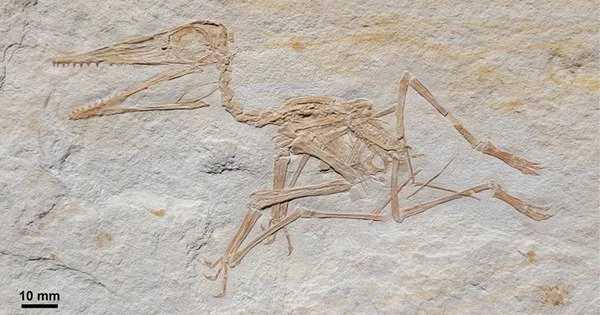Few pterosaurs lived near the places where fossils form. Because of the fragility of their bones, pterosaur fossils are frequently incomplete. Paleontologists must frequently gather information from multiple fossils or draw conclusions from more well-known pterosaurs to form a picture of a specific species.
Pterosaurs, or flying reptiles of the dinosaur era, first appeared in the Late Triassic period (227 million years ago) and went extinct during the Cretaceous extinction event (66 million years ago). They dominated the world’s skies for more than 160 million years, with wing spans ranging from 1 to 12 meters.
Pterodactylus from the famous Solnhofen Limestone of Bavaria, southern Germany, was the first described and named pterosaur, and the name of the entire group. The fossil, first described in 1784 by the Italian naturalist Cosimo Alessandro Collini, was thought to be an aquatic animal for 25 years before Georges Cuvier discovered it was a flying reptile belonging to a previously unknown group.
The oldest specimen of this iconic pterosaur was recently discovered near Painten, a small town in the southern part of the Franconian Alb in central Bavaria. The fossil, described in the journal Fossil Record, is approximately one million years older than other Pterodactylus specimens.
Pterodactylus specimens are not evenly distributed across the entire size range, but instead fall into distinct size classes separated by distinct gaps. The Painten specimen is a rare example of the first size gap between small and large.
Felix Augustin
The specimen was discovered during excavations in an active limestone quarry in 2014. It took the researchers more than 120 hours of meticulous mechanical work with pneumatic tools and needles before they could study it. The discovery was made by Felix Augustin, Andreas Matzke, Panagiotis Kampouridis, and Josephina Hartung of the University of Tübingen (Germany), as well as Raimund Albersdörfer of the Dinosaurier Museum Altmühltal.
“The quarry rocks that yielded the new Pterodactylus specimen are silicified limestone that has been dated to the upper Kimmeridgian stage (around 152 million years ago),” explains Felix Augustin of the University of Tübingen, the study’s lead author.
“Previously, Pterodactylus had only been found in younger rocks of southern Germany belonging to the Tithonian stage that follows after the Kimmeridgian.”

The object is a complete, well-preserved skeleton of a small person. “A small portion of the left mandible, as well as the left and right tibia, is missing. Aside from that, the skeleton is nearly perfect, with every bone present and roughly in its correct anatomical position “in their study, the researchers write
The Painten Pterodactylus is a rare “sub-adult” individual with a 5 cm-long skull.
“Pterodactylus specimens are not evenly distributed across the entire size range, but instead fall into distinct size classes separated by distinct gaps. The Painten specimen is a rare example of the first size gap between small and large” Augustin elaborates.
“The Painten Pterodactylus was of an intermediate, and rarely found, ontogenetic age at the time of its death, between two consecutive year classes.”
Many other “exquisitely preserved fossils” have been discovered at the Painten quarry, including ichthyosaurs, turtles, marine and terrestrial crocodile relatives, and dinosaurs. Many of them, including this new pterosaur specimen, are on display at Denkendorf’s new Dinosaurier Museum Altmühltal (Bavaria, Germany).
Pterodactylus was a generalist carnivore that most likely consumed a wide range of invertebrates and vertebrates. Pterodactylus, like all pterosaurs, had wings made of a skin and muscle membrane that stretched from its elongated fourth finger to its hind limbs. It was held together on the inside by collagen fibers and on the outside by keratinous ridges.
















